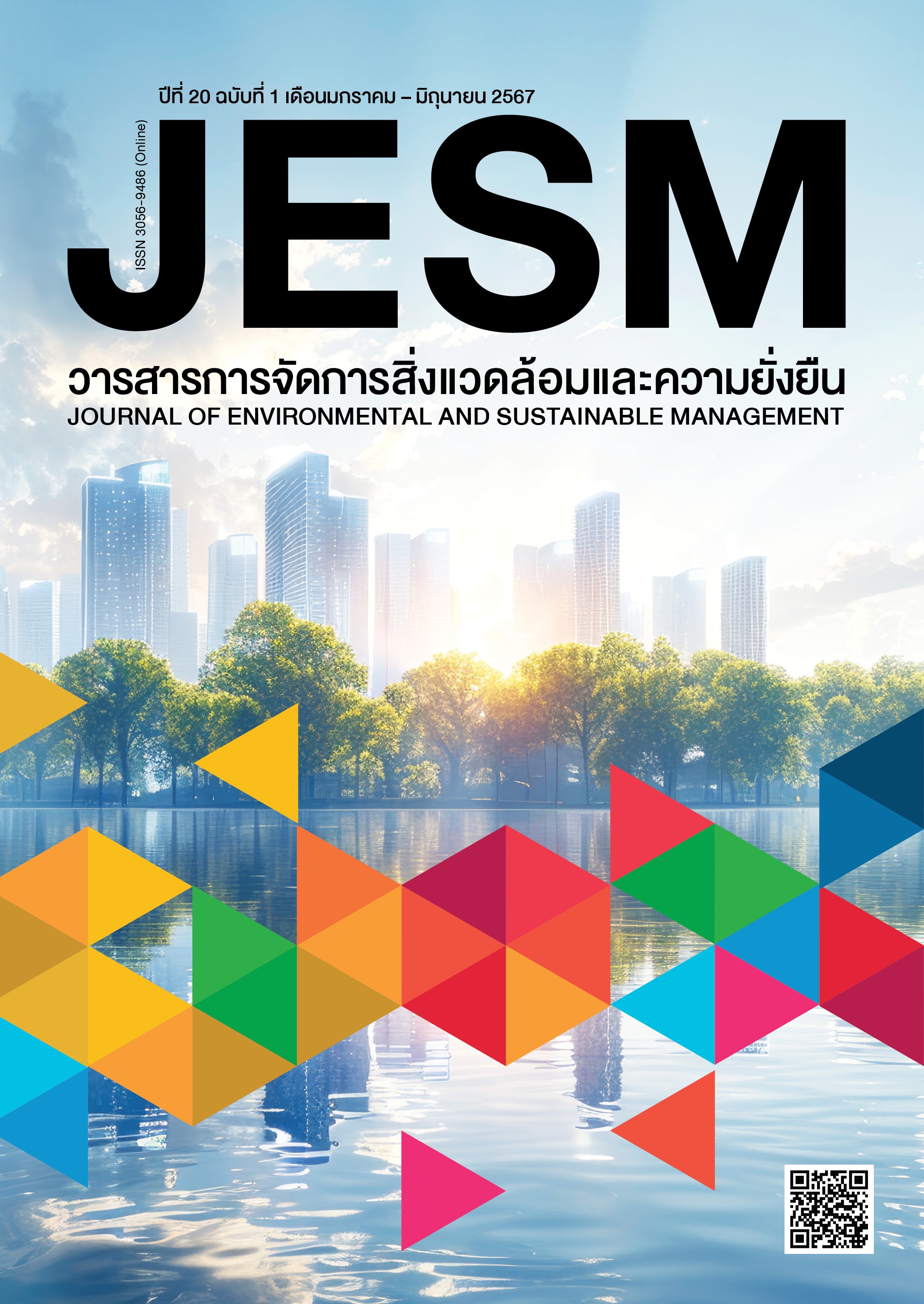การศึกษาการเปลี่ยนแปลงการใช้ที่ดินและแนวโน้มการใช้ที่ดินโดยใช้แบบจำลอง CLUMondo ร่วมกับกระบวนการประชาชนมีส่วนร่วม
DOI:
https://doi.org/10.14456/jesm.2024.7คำสำคัญ:
การเปลี่ยนแปลงการใช้ประโยชน์ที่ดิน, แบบจำลอง CLUMondo, ลุ่มน้ำสาขาห้วยกระเสียว, การวางแผนการใช้ที่ดินบทคัดย่อ
การใช้เทคโนโลยีภูมิสารสนเทศวิเคราะห์การใช้ที่ดินในลุ่มน้ำสาขาห้วยกระเสียว ปี 2549 ถึงปี 2564 พบว่า พื้นที่เกษตรกรรมเป็นส่วนใหญ่ รองลงมาคือพื้นที่ป่าไม้ สิ่งปลูกสร้างและที่อยู่อาศัย แหล่งน้ำ และพื้นที่เบ็ดเตล็ด ตามลำดับ โดยพบพืชไร่มากที่สุด รองลงมาเป็นนาข้าว ไม้ยืนต้น และไม้ผล เมื่อวิเคราะห์การเปลี่ยนแปลงการใช้ประโยชน์ที่ดินระหว่างปี 2549 ถึงปี 2564 กลับพบว่าพื้นที่เกษตรกรรม และพื้นที่ป่าไม้ มีแนวโน้มลดลง ขณะที่สิ่งปลูกสร้างและที่อยู่อาศัย แหล่งน้ำ และพื้นที่เบ็ดเตล็ด มีแนวโน้มเพิ่มขึ้น นอกจากนั้นแล้วยังพบว่าพื้นที่ปลูกข้าวโพดและอ้อยมีแนวแนวโน้มลดลง ขณะที่พื้นที่ปลูกมันสำปะหลัง ปาล์มน้ำมัน ยางพารา และไม้ผลมีแนวแนวโน้มเพิ่มขึ้น การคาดการณ์การใช้ประโยชน์ที่ดินโดยใช้แบบจำลอง CLUMondo ในอีก 20 ปีข้างหน้า (ปี 2584) โดยกำหนดการใช้ประโยชน์ที่ดิน 5 แนวทาง ได้แก่ 1) การใช้ที่ดินเหมือนกับแนวโน้มการใช้ที่ดินในอดีต 2) การใช้ที่ดินตามความต้องการของตลาดอ้อย 3) การใช้ที่ดินตามความต้องการของตลาดมันสำปะหลัง 4) การใช้ที่ดินตามความต้องการของตลาดอ้อยและมันสำปะหลัง และ 5) การใช้ที่ดินตามแนวทางการอนุรักษ์ดินและน้ำ ซึ่งพบว่าผู้มีส่วนได้ส่วนเสียต้องการการใช้ประโยชน์ที่ดินให้เป็นไปตามแนวทางที่ 3 และแนวทางที่ 5 สอดคล้องกับการสนับสนุนจากทางภาครัฐและปัญหาสิ่งแวดล้อมที่เกิดขึ้นในพื้นที่
เอกสารอ้างอิง
Baim, Y., Qin, J., Liu, W., Li, L., Wu, Y., & Zhang, P. (2024). The DPSIR Mobel-based Sustainability Assessment of Urban Water Resources: A comparative Study of Zhuhai and Macao. Water, 16(10), 1413.
Mallinis, G., Mitsopoulos, L., & Chrysafi, I. (2016). Evaluating and comparing Sentinel 2A and Landsat-8 Operational Land Imager (OLI) spectral indices for estimating fire severity in a Mediterranean pine ecosystem of Greece. GIScience & Remote Sensing, 55(1), 1-18.
Obubu, J.P., Odong, R., Alamerew, T., Fetahi, T., & Mengistou, S. (2022). Application of DPSIR model to identify the drivers and impacts of land use and land cover changes and climate change on land, water, and livelihood in the L. Kyoga basin: implications for sustainable management. Environmental Systems Research, 11(2022).
Office of farmer council Suphanburi province. (2021). Agricultural development plan of Suphanburi Provinces year 2021 – 2026. Retrieved October 15, 2022, from https://www.opsmoac.go.th/suphanburi-dwl-files-441691791155.
Office of public participation supporting, Royal irrigation department. (2011). Stepping towards success in irrigation management with farmers participating in the Water delivery and maintenance project Suphanburi Province. Retrieved October 15, 2022, from https://tarr.arda.or.th/preview/item/TSt0uAo-xtI0Iox0MM7iP?keyword=.
Poomisingharat, K. (2016). The sustainability of public participation in water management: case study of Krasiew Dam in Suphanburi Province. Thammasat University.
Sribunkhum, A., Kunta, K., & Arunyawat, S. (2021). Factors Affecting the Land use Change in Lam Dom Yai Subwatershed. Burapha Science Journal, 26(3), 1777-1795.
Suphanburi Province. (2022). Provincial development plan year 2023 – 2027. Retrieved October 15, 2022, from https://ww1.suphanburi.go.th/ebook/detail/17/data.html.
Suphanburi Provincial Administrative Organization. (2022). Natural resource and environmental information. Retrieved October 15, 2022, from https://www.suphan.go.th/content-10-421.html.
Verburg, P.H., Soepboer, W., Veldkamp, A., Limpiada, R., & Espaldon, V. (2002). Modeling the Spatial Dynamics of Regional Land Use: The CLUE-S Model. Environmental Management, 30(3),1011–1016.
Verburg, P.H. (2015). The CLUMondo land use change model: Manual and exercises. Retrieved October 15, 2022, from https://csdms.colorado.edu/csdms_wiki/images/CLUMondo_exercises_website.pdf.



